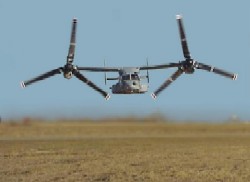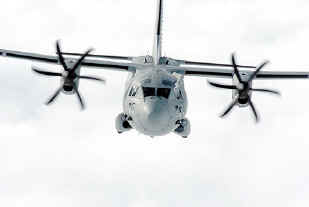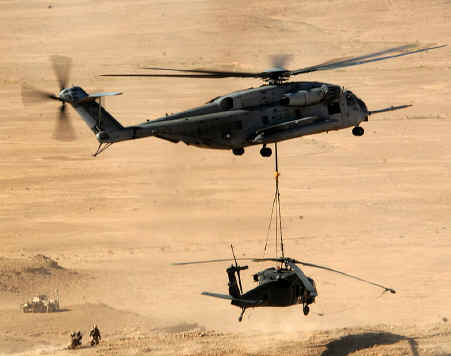 Compare the V-22
(right) with the new C-27J Spartan military transport (below), not be confused
with the much older C-27A once used by the USAF. This aircraft uses the
same two engines as the V-22 and is roughly the same size, measured in empty
weight. Yet the Spartan can carry twice the payload of the V-22 three
times farther. Its larger cabin can carry a Hummer or several more troops than a
V-22.
Compare the V-22
(right) with the new C-27J Spartan military transport (below), not be confused
with the much older C-27A once used by the USAF. This aircraft uses the
same two engines as the V-22 and is roughly the same size, measured in empty
weight. Yet the Spartan can carry twice the payload of the V-22 three
times farther. Its larger cabin can carry a Hummer or several more troops than a
V-22.
Most of this is because the Spartan has small twisted propellers, but also because the V-22 has short wings to save weight and fit aboard ship. A tiltrotor can fly like an airplane, but with less than half its performance in payload and range. Cruise speed is lower as well, around 240 knots for the V-22 vs. 305 knots for the Spartan.
 The most direct
comparison with a helo is with the CH-53K, which is the roughly the same empty
weight. The V-22 can carry only one-quarter its
payload and has less range. This is because the CH-53K's big flat rotors
are designed to pick things up. Nevertheless, the V-22 can cruise faster,
240 knots vs 170 knots for the CH-53K.
The most direct
comparison with a helo is with the CH-53K, which is the roughly the same empty
weight. The V-22 can carry only one-quarter its
payload and has less range. This is because the CH-53K's big flat rotors
are designed to pick things up. Nevertheless, the V-22 can cruise faster,
240 knots vs 170 knots for the CH-53K.
The Center for Defense Information recently released a detailed
report on the
V-22 that covers why proprotors perform poorly. They are a compromise
between propellers and rotors, so they perform less than half as well in either
mode. CDI is run by retired military officers and provides some of the best
independent defense analysis in the
Bell and Boeing discovered that tiltrotors were a bad idea in the early 1980s, so the Bush I administration tried to cancel the program. Since then, the Bell-Boeing team did everything they could to cut empty weight to improve performance. They used lightweight composite skin, even though it catches fire easy and produces toxic smoke, and damage is not really repairable since it is cast as one piece, like a cheap plastic patio chair.
They made the cabin 25% smaller than the CH-46E. They dropped the need to pressurize and fully heat or cool the cabin. They dropped the NBC protection. They made the ramp and floor so light that floor spacers are sometimes required. They dropped the chin gun. They delayed the hoist and deicing until after OPEVAL. Performance is still horrible. It may be fun to fly around mostly empty as has been done for decades, but Marines want V-22s to move lots of stuff, and they are shocked at its poor performance.
 The second
reason tiltrotors fail is they are unstable at slow speed. The
The second
reason tiltrotors fail is they are unstable at slow speed. The
The link above notes that the Navy dropped out of the XC-142 program because it considered its downwash too heavy since its disc loading was over 10. In comparison, the CH-46E has a disc loading of 4.2, the CH-60 has a disc loading of 7.19, while the V-22 has a tornado-like disc loading of 20.9. This has contributed to V-22 maintenance problems since vertical landings at unimproved sites produce massive dust clouds that are ingested into its engines. This is why V-22s rarely stray from hard surface runways, and prefer rolling take-offs to outrun any dust.
No TRAPs for V-22s
 A
mission practiced by Marines is the Tactical Recovery of Aircraft and Personnel
(TRAP). Helicopters often must make emergency landings in hostile areas because
of engine problems or battle damage. Recovery teams are quickly dispatched to snatch up the downed helo and its personnel before the enemy closes
in. This mission has been executed several times in
A
mission practiced by Marines is the Tactical Recovery of Aircraft and Personnel
(TRAP). Helicopters often must make emergency landings in hostile areas because
of engine problems or battle damage. Recovery teams are quickly dispatched to snatch up the downed helo and its personnel before the enemy closes
in. This mission has been executed several times in
However, the V-22 is
twice as large as a CH-46E, and thus too heavy for America's largest helicopter,
the new CH-53K, to lift. As a result, V-22s that
must land near hostile forces will be abandoned and destroyed if they
cannot be repaired and airborne within an hour. Even in safe areas, it
may prove impossible to recover a downed V-22 in rough terrain
due to a lack of good road access, since this requires a large crane as well as
a large tractor trailer truck. As a result, Marines may destroy V-22s that are forced to land
for minor
mechanical reasons. Local commanders will not have resources or risk lives
needed for a week-long ground recovery effort
Flogging Truth Tellers
A few years ago, the consumer technology industry became aware of the threat of internet forums. People could publish negative info and insiders could covertly blow whistles. Companies soon directed their advertising firms and public relations officers to engage in what has become known as "flogging." They pose as regular folks to write about their great product. They attack anyone who posts negative views with childish insults, in hopes of quieting the truth.Defense contractors joined in several years ago. They destroyed most military forums with their full-time floggers. They pose as experts and dismiss negative reports as "old news" and claim problems have been fixed. They accuse negative posters of working for a rival company, and dismiss critical media reports as ill informed. They claim that negative postings are "opinions" not facts, which can only come from the contractor. They badger those who post inside info to fully identify themselves so they can contact their bosses and have them fired.
At places like military.com, they pressured the editor to remove moderators and put one of their boys in charge, so he can delete entries and ban anyone with bad news. (Contractors are often advertisers on a website, so they carry clout) Some V-22 forums like at popasmoke.com now review postings in advance to keep out what they call "bad info." Aviation Week once had great forums, but closed them because of contractor complaints. They recently started them again, but topics must be pre-approved, and those about the pros and cons of weapons systems are taboo. Former V-22 maintenance chief Josh Brannon started a web forum in 2007 to allow open discussion of the V-22. He struggled to moderate a discussion forum as floggers appeared to attack posters. After a couple of months, his web host sponsor removed the forum, and refused to offer an explanation.
If you notice rude fanatics on any Internet forum that show
little interest in discussing issues and only seek to advertise products and
demean critics, they are probably paid floggers.
Carlton Meyer
©2008 www.G2mil.com